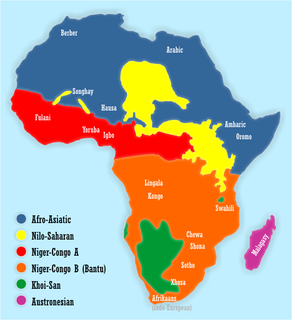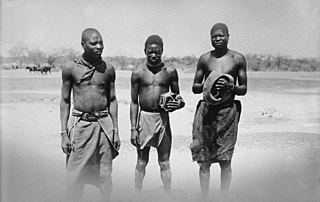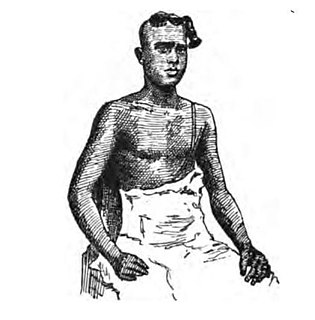Related Research Articles

The Bantu languages are a large family of languages spoken by the Bantu peoples throughout sub-Saharan Africa.

Matrilineality is the tracing of kinship through the female line. It may also correlate with a social system in which each person is identified with their matriline – their mother's lineage – and which can involve the inheritance of property and/or titles. A matriline is a line of descent from a female ancestor to a descendant in which the individuals in all intervening generations are mothers – a "mother line". In a matrilineal descent system, an individual is considered to belong to the same descent group as their mother. This ancient matrilineal descent pattern contrasts with patrilineal descent from which a family name is usually derived. The matriline of historical nobility was also called their enatic or uterine ancestry, corresponding to the patrilineal or "agnatic" ancestry.
The Lemba, wa-Remba, or Mwenye are a Bantu ethnic group which is native to Zimbabwe and South Africa, with smaller, little-known branches in Mozambique and Malawi. According to Tudor Parfitt, Professor of Oriental and African Studies at the University of London, in 2002 they numbered an estimated 50,000. They speak the Bantu languages spoken by their geographic neighbours and resemble them physically, but they have some religious practices and beliefs similar to those in Judaism and Islam, which they say were transmitted by oral tradition.

Khoisan, or according to the contemporary Khoekhoegowab orthography Khoe-Sān, is a catch-all term for the "non-Bantu" indigenous peoples of Southern Africa, combining the Khoekhoen and the Sān or Sākhoen.

East Africa or Eastern Africa is the eastern subregion of the African continent, variably defined by geography. In the United Nations Statistics Division scheme of geographic regions, 20 territories make up Eastern Africa:

In anthropology, pygmy peoples are ethnic groups whose average height is unusually short. The term pygmyism is used to describe the phenotype of endemic short stature for populations in which adult men are on average less than 150 cm tall.

The Bantu expansion was a major series of migrations of the original Proto-Bantu-speaking group, which spread from an original nucleus around West-Central Africa across much of sub-Saharan Africa. In the process, the Proto-Bantu-speaking settlers displaced or absorbed pre-existing hunter-gatherer and pastoralist groups that they encountered.
In historical linguistics, the homeland or Urheimat of a proto-language is the region in which it was spoken before splitting into different daughter languages. A proto-language is the reconstructed or historically-attested parent language of a group of languages that are genetically related.
Iroquois kinship is a kinship system named after the Haudenosaunee people that were previously known as Iroquois and whose kinship system was the first one described to use this particular type of system. Identified by Lewis Henry Morgan in his 1871 work Systems of Consanguinity and Affinity of the Human Family, the Iroquois system is one of the six major kinship systems.

The Ovambo people ,also called Aawambo, Ambo, Aawambo, or Ovawambo (Kwanyama), are a Bantu ethnic group native to Southern Africa, primarily modern Namibia. They are the single largest ethnic group in Namibia, accounting for about half of the population. They are also found in southern Angolan province of Cunene where they are more commonly referred to as "Ambo". The Ovambo consist of a number of kindred Bantu ethnic tribes who inhabit what was formerly called Ovamboland. In Angola, they are a minority, accounting for about two percent of the total Angolan population.

The Siddi, also known as Sidi, Siddhi, Sheedi or Habshi, are an ethnic group inhabiting India and Pakistan. Members are descended from the Bantu peoples of Southeast Africa. Some were merchants, sailors, indentured servants, slaves and mercenaries. The Siddi population is currently estimated at around 270,000–350,000 individuals, with Karnataka, Gujarat and Hyderabad in India and Makran and Karachi in Pakistan as the main population centres. Siddis are primarily Muslims, although some are Hindus and others belong to the Catholic Church.
Haplogroup L2 is a human mitochondrial DNA (mtDNA) haplogroup with a widespread modern distribution, particularly in Subequatorial Africa. Its L2a subclade is a somewhat frequent and widely distributed mtDNA cluster on the continent, as well as among African Americans.
The Khoe languages are the largest of the non-Bantu language families indigenous to southern Africa. They were once considered to be a branch of a Khoisan language family, and were known as Central Khoisan in that scenario. Though Khoisan is now rejected as a family, the name is retained as a term of convenience.

The Iraqw or Irakw are a Cushitic-speaking ethnic group inhabiting the Great Lakes region of East Africa. They live in the Arusha and Manyara regions of north-central Tanzania, near the Rift Valley wall and south of Ngorongoro Crater.

The Nambudiri, also transliterated Nambūdiri, Namboodiri, Namboothiri, and Nampūtiri, are a Malayali Brahmin caste, native to what is now the state of Kerala, India.
The Prehistory of South Africa lasts from the Middle Stone Age until the 17th century. Southern Africa was first reached by Homo sapiens before 130,000 years ago, possibly before 260,000 years ago. The region remained in the Late Stone Age until the first traces of pastoralism were introduced about 2,000 years ago. The Bantu migration reached the area now South Africa around the first decade of the 3rd century, over 1800 years ago, largely displacing the indigenous Khoisan population.Early Bantu kingdoms were established by the 11th century. First European contact dates to 1488, but European colonization began in the 17th century.
The Somali Bantu are a Bantu-speaking origin ethnic marginalized group(s) in Somalia who primarily reside in the southern part of the country, primarily near the Jubba and Shabelle rivers. They are descendants of people from various Bantu ethnic groups, who were acquisitioned from Southeast Africa and in Somalia and other areas in Northeast Africa, and West Asia as part of the Indian Ocean slave trade. Somali Bantus are not genetically related to the indigenous ethnic Somalis and have a culture which since their arrival in the country, has been distinct from the indigenous Somalis who are Cushitic and they have remained marginalized ever since their arrival in Somalia.In 1991, 12,000 Bantu people were displaced into Kenya, and nearly 3,300 were estimated to have returned to Tanzania.

The Twa are a group of indigenous African Pygmy tribes.
The Cimba[tʃimba], also spelled Tjimba, are a remote, Herero-speaking hunter-gatherer people of the Kaokoveld desert in northwest Namibia and southwest Angola, in the mountain ranges bordering the Kunene River. They continue to use stone tools, and use Adenium boehmianum to poison their arrows.
Bantu peoples are the speakers of Bantu languages, comprising several hundred indigenous ethnic groups in sub-Saharan Africa, spread over a vast area from Central Africa across the African Great Lakes to Southern Africa.
References
- ↑ Holden, Clare–Janaki; Ruth, Mace (2003). "Spread of cattle led to the loss of matrilineal descent in Africa: a coevolutionary analysis". Proceedings of the Royal Society of London B. 270: 2425–2433. doi:10.1098/rspb.2003.2535. PMC 1691535 . PMID 14667331.
- ↑ Kuper, Adam; Van Leynseele, Pierre (1978). "Social Anthropology and the 'Bantu expansion'". Africa: Journal of the International African Institute. 48 (4): 335–352. doi:10.2307/1158800.